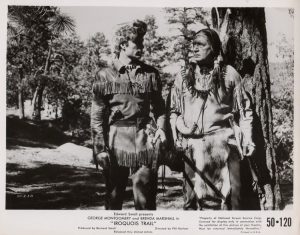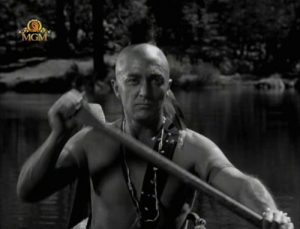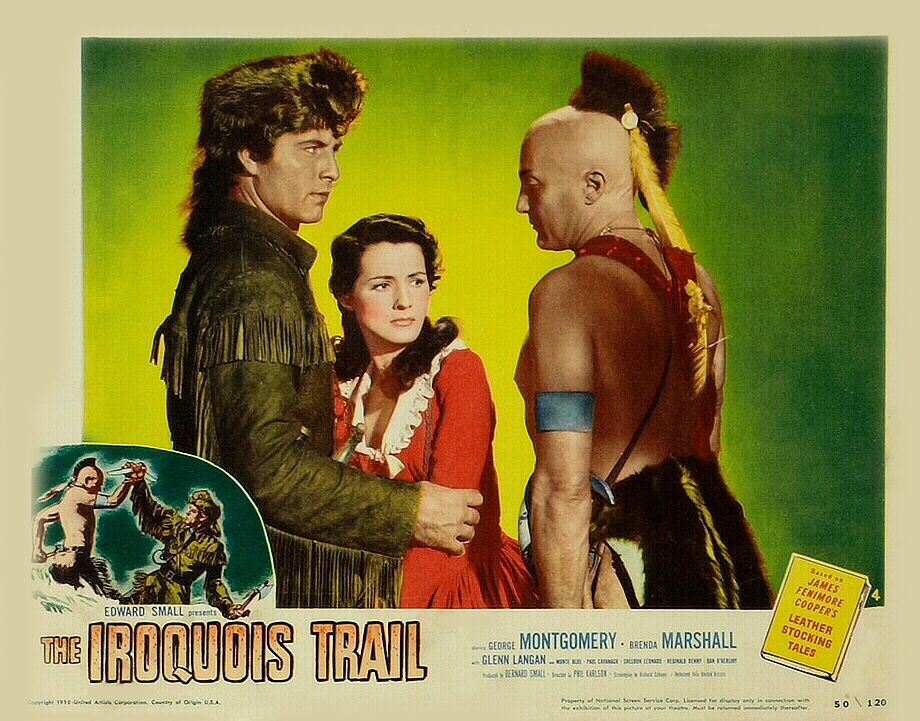One of the things about doing newspaper research, I find, is how easily it can lead to distraction. I am at a point in my research where I am still formulating questions, where I still have so much to learn. I am not looking for any one thing. Rather, I am trying to collect as much information as I can about the Onondagas and their history. In this sense, nothing I find is irrelevant, and everything I read might be significant, even if I do not know now what I might eventually do with that information.
In 1950, Bernard and Edward Small produced a film called “The Iroquois Trail.” To generate publicity, the producers staged a screening in Syracuse, the “hometown of Hiawatha,” they said. I would never have known about this film had I not read the Syracuse papers looking for information about the Onondagas.
So armed with Wi-Fi, Youtube, and an hour-and-a-half workout at the gym, I watched “The Iroquois Trail.” It was bad. Like, “what was wrong with these people?” bad.
Based loosely upon James Fenimore Cooper’s The Last of the Mohicans,” a novel I loathe from the very pit of my soul, “The Iroquois Trail” contains elements that  Cooper’s readers would have recognized as kinda-sorta similar to the novel. Instead of Natty Bumpo, the film focuses upon Nat Cutler. Played by George Montgomery, Cutler is a fast-talking, witty frontiersman with a stupid, coonskin cap, a desire to avenge his murdered kid brother, and a determination to prevent the British from marching into a military blunder. Instead of Chingachgook, Cutler’s sidekick is the redundantly-named “Chief Sagamore,” loyal and committed until the end. Ogana, their nemesis, serves the same function as did Magua in Cooper’s novel, a malevolent double-crosser who hates the English and lusts after “Yankee scalps and a white woman for his tepee,” thus preserving Cooper’s interest in transgressive interracial sex. And everyone contends for the British fort commander’s daughter. The struggle between France and Great Britain for control of the Hudson-Champlain waterway during the Great War for Empire serves as the setting. But less than a distillation of Cooper, “The Iroquois Trail” seems more like a summary written by a school kid who did not understand the original.
Cooper’s readers would have recognized as kinda-sorta similar to the novel. Instead of Natty Bumpo, the film focuses upon Nat Cutler. Played by George Montgomery, Cutler is a fast-talking, witty frontiersman with a stupid, coonskin cap, a desire to avenge his murdered kid brother, and a determination to prevent the British from marching into a military blunder. Instead of Chingachgook, Cutler’s sidekick is the redundantly-named “Chief Sagamore,” loyal and committed until the end. Ogana, their nemesis, serves the same function as did Magua in Cooper’s novel, a malevolent double-crosser who hates the English and lusts after “Yankee scalps and a white woman for his tepee,” thus preserving Cooper’s interest in transgressive interracial sex. And everyone contends for the British fort commander’s daughter. The struggle between France and Great Britain for control of the Hudson-Champlain waterway during the Great War for Empire serves as the setting. But less than a distillation of Cooper, “The Iroquois Trail” seems more like a summary written by a school kid who did not understand the original.
It is difficult to know where to start in listing the problems with the film. The producers filmed it around Big Bear Lake, and any Californian would recognize that at the outset. Northern New York does not look like that. Only a few Indian actors appeared in the film and, save for Monte Blue, who played Sagamore and claimed some Native American descent on his father’s side, only in small and uncredited parts. Ogana, the villain, was played by Sheldon Leonard, a Jewish-American actor from New York City best known for playing tough guys and for a small role in “It’s a Wonderful Life.” The Indian-speak of the native characters is grating, the deployment of Native American stereotypes so heavy-handed. The dialogue is terrible, the characters’ motivations muddled, and the entire production lazy. I was relieved that it was not nearly as long as I expected.
The Indian-speak of the native characters is grating, the deployment of Native American stereotypes so heavy-handed. The dialogue is terrible, the characters’ motivations muddled, and the entire production lazy. I was relieved that it was not nearly as long as I expected.
The film itself was entirely predictable, completely uninteresting, poorly acted, unevenly paced, and carelessly written. Still, its promotion in Syracuse did interest me. The Strand Theatre teamed up with Boy Scouts of America to promote the film and public safety. “Traffic signal standards will be posted with caution signs keyed to the city’s historic locale on the old Iroquois trail, which crossed the state from Albany to Niagara,” the Syracuse Post-Standard reported on 12 July 1950. When the film finally premiered later that month, the young audience was “constantly vocal in tribute to the red-blooded adventure story,” and “in a hissing mood against Ogana, the proud Huron chief (well-played by shaved-head Sheldon Leonard) who used every deceit known, playing France against English and colonials.” The audience, the Post-Standard reporter indicated, was “delighted” by the movie.
And in all of this–a film set in New York during the Great War for Empire, a publicity campaign that capitalized on the city’s ties to the history of the Haudenosaunee–no mention was made of the actual Onondagas, whose reservation boundary was just a few minutes away from the theater. It was during these years that Iroquois people gathered at the New York State Fair grounds in Syracuse at the Indian Village dressed in Plains Indians clothing because white people needed to see that in order to recognize them as authentic. Movies like “The Iroquois Trail” taught audiences that native peoples were part of the past, that they were either noble or ignoble, but in all cases part of the past. The filmmakers and the promoters appropriated a story and a piece of history and marketed it as relevant to the history of people who lived in Central New York. But they felt no need to visit real native peoples, to speak with them, and learn their histories. There is no word in the paper if any Onondagas traveled in to town to catch the movie before it disappeared.



Your loathing of Last of the Mohicans disqualifies you from commenting on the films or anything else related to Cooper. You make the mistake of projecting your 21st century value system on 18th century pioneer life. I wonder how you would react to your children being kidnapped or your relatives and neighbors tortured and murdered had you lived in those times.
There are better films than this one to comment on but you apparently chose this one to better support your pro ‘Native American’ bias.
PS: American Indians did not consider themselves or call themselves American.
Tim,
Thanks for you post, but I have to admit I am a little unclear as to what point you are trying to make. I am disqualified from commenting on Cooper because I thought his novel was vastly overrated, and the Michael Mann film was a steaming pile of nonsense? That’s circular and silly. I wrote about the “Iroquois Trail” because it was heavily promoted in Syracuse, New York, and Onondagas were invited to the screening. I am working on a history of the Onondaga Nation.
Certainly there was plenty of violence to go around on the frontier, and of course I would not be happy if bad things happened to my family. That is a pretty obvious statement. But this is not really about me, is it? After all, any glance at the history of this continent shows that native peoples were far more often and far more likely to be on the receiving end of any violence than the perpetrators. I would challenge you to explain your point about my “Native American bias”: can you cite one example in something I have written where I did not support my assertion with evidence? I will wait.
And as for your postscript……I really haven’t the faintest idea what you are trying to say. I look forward to hearing more from you.
I like Indians in General and they are pretty amazing by many standards !
But sir … you must admit that they were Extremely dangerous and cruel …. as a rule !
This does not mean that whites were not cruel …..
During a war everything is allowed …. though !
But when you act with cruelty …. during a war ….
you must admit that
… For instance Custer was extremely cruel …. &
he paid for that ! …. I think !!
Sitting Bull himself admitted being cruel against the Whites ….\
and he said ” After all the torturing and Killing I have done … Peace with the Whites , I know is impossible !”
Sitting Bull was a great guy to me much greater than Custer …. for sure ….
He Explained that a Worrior is CRUEL …. because of the weak people and loved ines He has to defend and protect !!
That is why He is excused ….. to a big DEGREE to me !!
But He never said I am kind & gentle !
Two-MOON is a Cheyenne CHIEF !
A great personage indeed !! [ like Sitting-Bull …to me ]
He said I killed a lot ….. now I understand &
I do not care about the past
I only want that my children leave in peace and go to school …
to learn the ways of the Whites !
{ He was a great warrior …. but BEFORE that his words show
that HE is a great intelligent and farsighted man ]
THE IROQUOIS were among the CRUELEST people …. [ ONEIDA especially] …. only rivalled by the Apache and the Hurons .
That is a fact ……
You can discuss the reason BEHIND ….
You cannot deny it !!
Although some say the Apache were worse ….
I was scared by the IROQUOIS and the HURON !
They were very interesting THOUGH and they had many good sides too !
For instance the Friendship between the HURON and Frenchman Mr. CHAMPLAIN has always amazed me !
Since so cruel they were and so friendly and well-disposed …. if you were able to touch the right chord !!
Regards